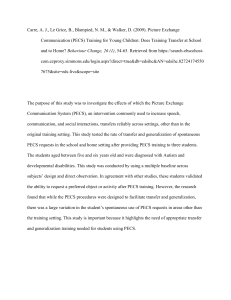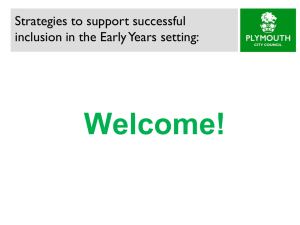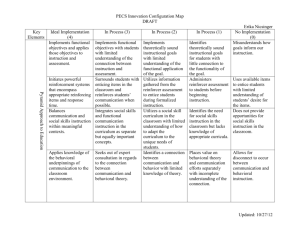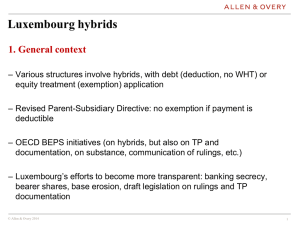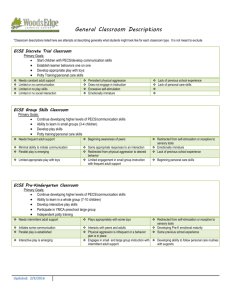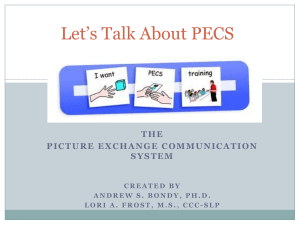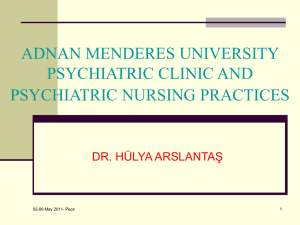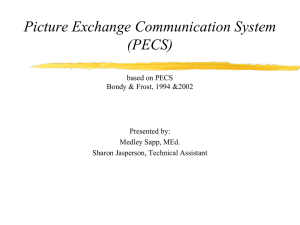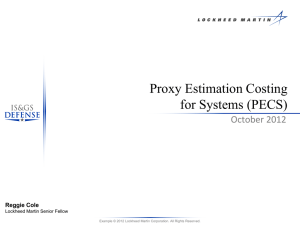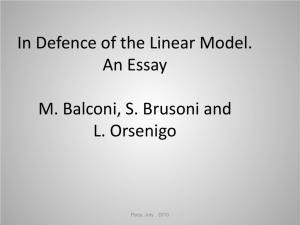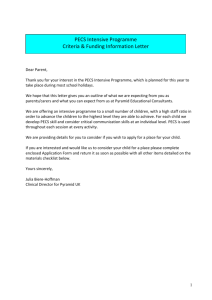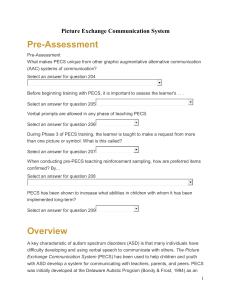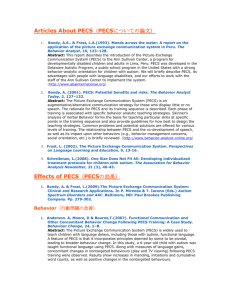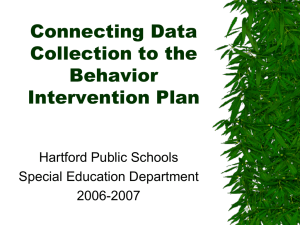Document 5350774
advertisement
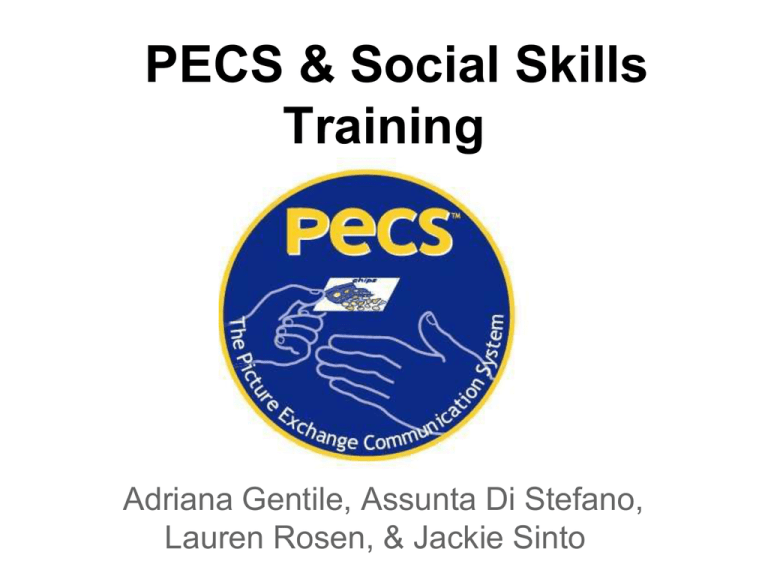
PECS & Social Skills Training Adriana Gentile, Assunta Di Stefano, Lauren Rosen, & Jackie Sinto Picture Exchange Communication System (PECS) Developed by Andy Bondy, Ph.D., and Lori Frost, M.S., in 1985. Alternative communication intervention for individuals with autism spectrum disorder and related developmental disabilities. Successful with individuals of all ages demonstrating a variety of cognitive, communicative, and physical difficulties. -Communication, social, and behavior skills are generally the primary targets for intervention. -PECS is based on B.F. Skinner’s Verbal Behavior where verbal operants are systematically taught using prompting and reinforcement strategies that will lead to independent communication. PECS Research Traditional communication strategies such as speech imitation techniques, sign language, and picture point systems required too many prerequisite skills and focused on the teacher beginning the interactions ->PECS focuses on teaching children the importance of initiation of communication with another individual Evidence of Effectiveness There are over 100 published articles providing the evidence of the effectiveness of PECS. PECS has been shown to: ● Foster independent communication skills ● Increase relatedness and emotional closeness ● Increase availability for learning and interaction ● Build spoken language skills ● Decrease negative behaviors that were caused by frustration -Bondy and Frost (1994), found that after one year, a majority of the preschoolers used in this study with Autism Spectrum Disorder transitioned to speech alone, while the remaining students were able to use a combination of speech plus PECS. -Charlop-Christy et al. (2002), studied the effect that PECS implementation has on decreasing contextually inappropriate behaviors that often result from an overall inability to communicate in children with ASD in academic and play settings, including tantrums, grabbing, out-of-seat behavior, and disruptive behaviors. A 70% reduction across behaviors and settings was noted. PECS Phases PECS begins by teaching an individual to give a picture of a desired item to a “communicative partner". This “communicative partner” immediately honors the exchange as a request. The system goes on to teach discrimination of pictures and how to put them together in sentences. In the more advanced phases, individuals are taught to answer questions and to comment. *Before implementing PECS, the teacher/communicative partner develops an inventory of which items the student likes. Phase I How To Communicate Students learn to exchange single pictures for items or activities they really want (reward). Demo Phase 1 Phase II Distance and Persistence Still using single pictures, students learn to generalize this new skill by using it in different places, with different people and across distances. This phase teaches students to be more persistent communicators and how to seek and obtain another person’s attention. Phase III Picture Discrimination Students learn to select from two or more pictures to ask for their favorite things. These are placed in a communication book—a ring binder with Velcro® strips where pictures are stored and easily removed for communication. Demo Phase III Phase IV Sentence Structure Students learn to construct simple sentences on a detachable sentence strip using an “I want” picture followed by a picture of the item being requested. *Verbal communication is encouraged during this phase. Students who are exchanging and speaking receive a larger amount of the reinforcer, or the reinforcer for a longer period of time. Demo Phase IV Phase V Answering Questions Students learn to use PECS to answer the question, “What do you want?”. The first four phases focuses on teaching initiation whereas this phase focuses on responding to questions. Phase VI Commenting Now students are taught to comment in response to questions such as, “What do you see?”, “What do you hear?” and “What is it?”. They learn to make up sentences starting with “I see”, “I hear”, “I feel”, “It is a”, etc. They are responding to occurrences in their environment. Demo Phase VI PECS Video http://www.youtube.com/watch?v=-Bzli1iC_w8 References Bondy, A., & Frost, L. (1994). The picture exchange communication system. Focus on autistic behavior, 9, 119. Charlop-Christy, M. H., Carpenter, M., Le, L., LeBlanc, L., & Kelley, K. (2002). Using the picture exchange communication system (PECS) with children with autism: Assessment of PECS acquisition, speech, socialcommunicative behaviors, and problem behaviors. Journal of applied behavior analysis, 35, 213-231. http://www.pecsusa.com/pecs.php http://www.autism-society.org/living-with-autism/treatmentoptions/pecs.pdf Technology Comp 13 • Jaclynn Sinto- Technology Competency 13 • • This PowerPoint presentation will be used to instruct a class on the benefits of using PECS (Picture Exchange Communication System). • • The PowerPoint includes, pictures, a movie, and a demonstration on how to use the system.
